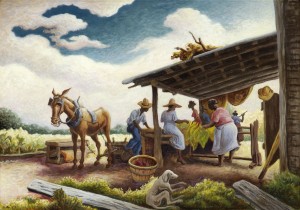Lesson Plan
Day 1
Direct Instruction
Read Jonkonnu, by Amy Littlesugar and Ian Schoenherr (15 min.). If desired, start by reading several pages, summarizing the rest to spark a class discussion about prejudice but how Winslow Homer did not waiver. Then the last two pages can be read to end the story.
Now discuss the vocabulary (5 min.) to review what they have learned.
Demonstrate how to draw with yellow chalk a simple shirt outline (basic T-shirt design or with collar) and pant/Capri outline. Divide the top and pants into sections. A different pattern is to be created in each section with colored materials. Patches, pockets in odd places are then added with lines drawn like “stitches” around each section and patch as details.
Guided Practice
Have students gather supplies and begin their own outlines of a shirt and pants. Once they have divided the top and pants into sections, they begin to fill in a section with a pattern of their choosing. Remind them to write their names on the back and save for next lesson.
Day 2
Direct Instruction
Demonstrate how to cut the outline of the shirt and pants, and draw “stitches” to add details (2 min.).
Guided Practice
Have students continue their work. They will create bold patterns in each section; cut out the outline of the shirt and pants; use scraps of negative space paper to create pockets and patches, drawing “stitches” around as if sewn; and add wallpaper scraps and fabric scraps to make the costumes unusual and unique.
Day 3
Direct Instruction
Demonstrate how to draw with yellow chalk an oval, neck, and large shoulders from the black construction paper, proportional to the costume design. Overlap the shirt onto the black paper and trace the size needed. From the black scraps, draw arms with simple “mitten” shaped hands and barefoot feet/legs. (Sandals can be added later.)
Show how to cut out all appendages and glue them to the back of costume pieces with the chalk edge not showing extending out from shirt neck, sleeves, and pants. Use odd fabric scraps to fashion a turban, scarf, or hat for the person created.
While students are independently working, add details to the kraft paper to depict a road, houses, and trees. The setting may be from the Caribbean, or from the South (U.S.) drawn in marker.
Guided Practice
Students create their silhouette as instructed and glue parts together. Then, they assemble their work with others on the kraft paper with smaller figures higher on the composition, and larger figures overlapping other figures lower on the large paper, creating a parade.
Classroom Extension Ideas
Continue the learning in this art lesson by bringing it back to the classroom. Here are some possible extension
activities:
- Have students write their own “how-to” pieces describing the steps they followed to create their own Jonkonnu figures.
- Continue to research Jonkonnu traditions in class. Using the class’s parade as inspiration and incorporating what they’ve learned about Jonkonnu, have students write a short historical fiction story.
- Connect this art activity to Black history during social studies.

